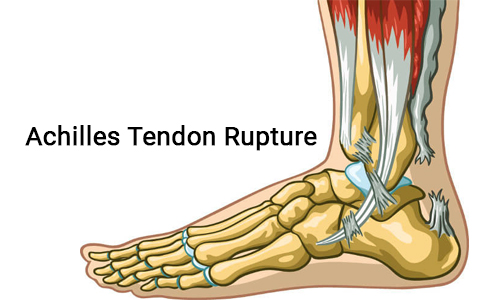ACHILLES TENDON RUPTURE
Achilles tendon is a strong fibrous cord located behind the ankle that connects the calf muscles to the heel bone. It is used when you walk, run and jump. The Achilles tendon ruptures most often in athletes participating in sports that involve running, pivoting and jumping. Recreational sports that may cause Achilles rupture include tennis, football, basketball and gymnastics.
To help prevent an Achilles tendon injury, it is a good practice to perform stretching and warm-up exercises before participating in any exercises or sports activities. Gradually increase the intensity and length of time of activity. Muscle conditioning may help to strengthen the muscles in the body.

When the Achilles tendon ruptures, you may hear a popping or snapping sound and you will experience severe pain in the back of your leg above your heel. You will also experience swelling, stiffness, and difficulty to stand on tiptoe and push the leg when walking.
Doctors diagnose the rupture based on symptoms, history of the injury and physical examination. Your doctor may also feel a gap or depression in the tendon, just above the heel bone. On the examination, the physician will gently squeeze the calf muscles. If the Achilles tendon is intact, there will be flexion movement of the foot, if it is ruptured, there will be no movement observed. On rare occasions, ultrasound or MRI is requested.
Achilles tendon rupture is mainly treated non-surgically with a cast or special brace which lifts your heel, allowing the tendon to heal. The cast is worn for roughly 3 weeks and then physiotherapy is started. Different braces are worn in order to help the tendon to heal for the following 3 weeks.
Surgical procedure involves opening the skin and suturing the torn tendon together. Surgery is only reserved for particular cases or when non-surgical treatment fails. Physical therapy is then recommended to improve the strength and flexibility of leg muscles and the Achilles tendon.
